- A Walk in the Chisinau Jewish Cemetery
- Christian History in Seoul – Graves and Buildings
In only 160 years since the first missionaries arrived in Korea a great turning to Christ occurred. The center of Seoul provides a great experience in finding out what these missionaries in Korea did right. I have mapped out a walking/subway tour that one can follow in a day or when in certain parts of the city.
Map of Christian History Tour in Seoul
I have created a map with these locations on Google Maps.

Yanghwajin Foreign Missionary Cemetery
This location is more than a graveyard. The location offers a very good summary of the mission history of this land. The key leaders who came in the late 1800s and early 1900s are buried here along with their families. About a fourth of the graves are missionaries or members of their families who served in this land. A visit there involves three stops: reception, cemetery, and the exhibition hall.
Hints in getting there: From the Hapjeong Metro stop, take exit 7. The entrance to the area is along side the enclosed subway track and has international flags flying upon the wall.


Book or visit the Reception Center
When I entered the complex, I mistakenly went towards the left, hoping to enter into the exhibition hall. The reception on the right organizes the tours and guides groups through the exhibition.
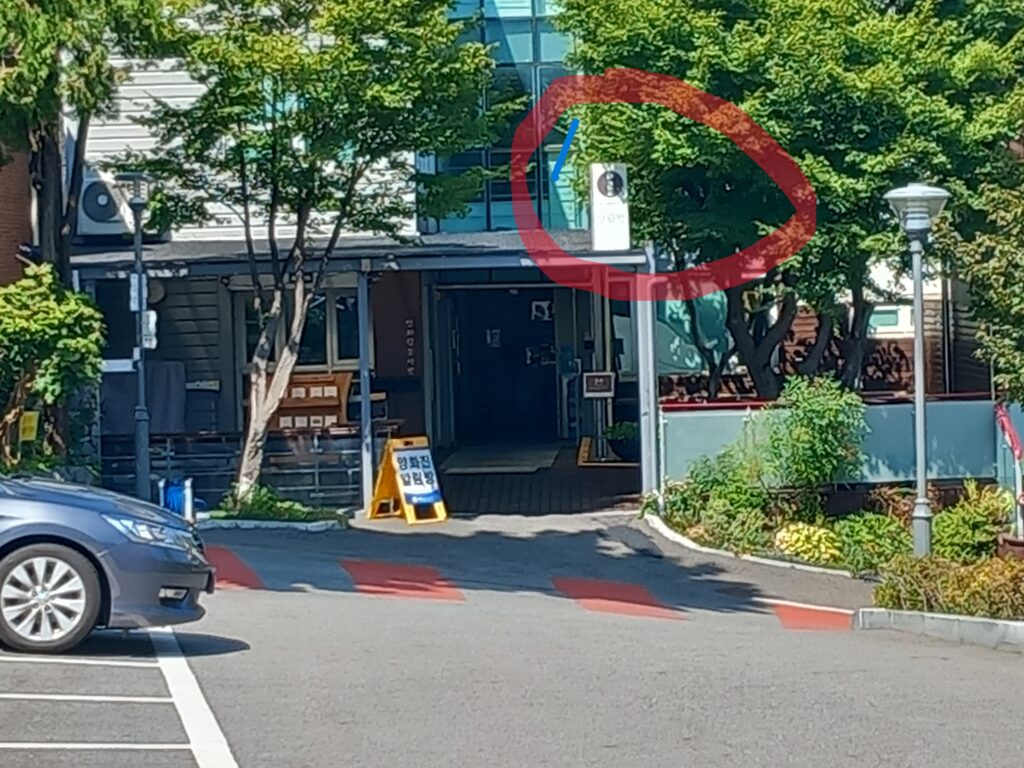
Available tours take place in the morning and afternoons, except for Sunday. In the reception area, an essential background video of the situation in Korea in the mid-1800s gives substantial background on why foreign missionaries had such opportunities.
At the reception, the introductory video is the best way to start exploring the cemetery. This video provides critical insight into the situation in Korea in the late 1800s.
Yanghwajin Cemetery
A tour is possible if you book it, especially for English speakers. However, while personally touring the cemetery, I found many graves and sections have write-ups in Korean and English. The majority of the early missionaries in Korea were in the lower back section. A few things that stood out to me when I visited. The grave markers are in English and Korean, sometimes with each taking a side of the stone. A very interesting section dedicated to infant burials toward the back of those who died from one day to one year of age. This showed the value of life despite the shortness of these little one’s life.
Graves of particular interest were the Russian Orthodox graves on the hillside near H.G. Underwood’s family plot. Why did they come there? Until 1917, an Orthodox mission was encouraged in the Russian East and Korea [1]https://www.sciencedirect.com/science/article/pii/S122954501400028X. The early missionaries were very open to collaboration in their medical, and educational work. Did they open up the site to others? It seems so, and I also saw a Seventh-day Adventist grave in the cemetery. The film in the reception area mentioned that the grave site was neglected for a number of years and many graves were damaged, which can be seen in some of the stones. These missionaries loved Korea and were more than willing to die here. The graveside gives insight into some families who, through generations, served this land.
Graves that Ponder
Charles W. LeGendre grave perked my interest. In his plot is his stone along with a stone from most likely Italy. Was this stone transplanted here, or did someone design it from a model? In my opinion, it appears to come from the Mediterranean area, and the year 1772 in Roman numerals is written on the back.
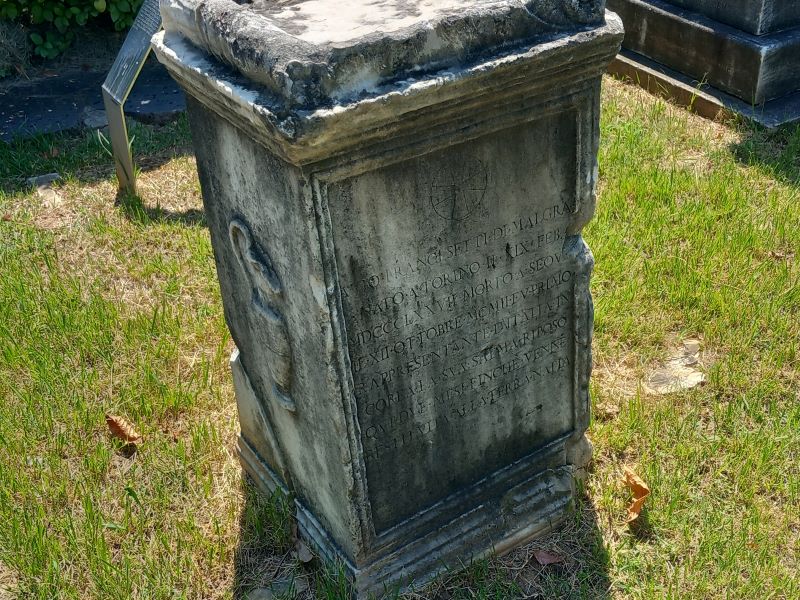
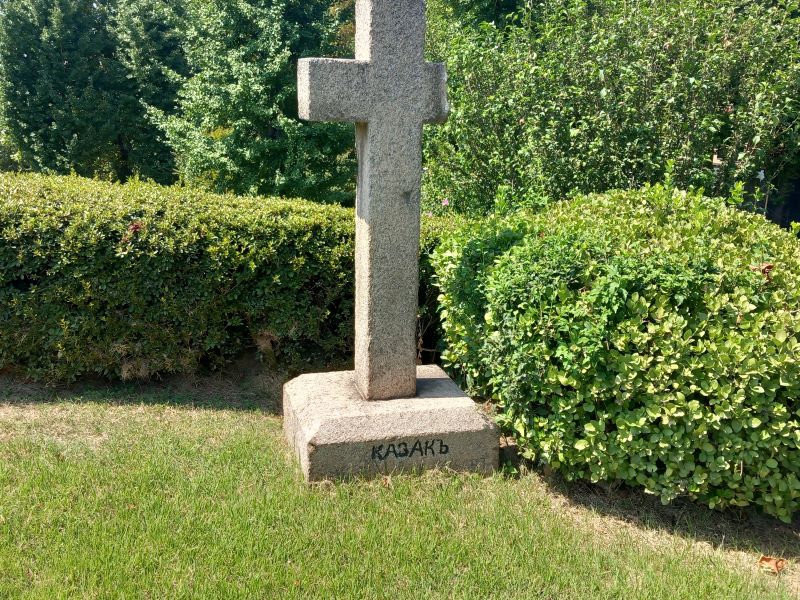
I asked my guide at the exhibition hall about this grave but received no answer, and none of the lists stated anything about this broken cross memorial. In Russian, it says, “Kazakh,” so was a Central Asian believer buried here also?
Exhibition Hall of Missionaries in Korea
This section highlights the educational, medical, and literary works that the missionaries did alongside Koreans. One will need to arrange this visit through the reception area. The video in this exhibition focuses on Bible translation. The devaluation of the Korean language by the Japanese powers who controlled the Korean peninsula throughout the 19th and early 20th centuries prepared the people’s hearts to receive the Word of God and gave worth to the gospel.
Jeoldusan Korean Martyrs Courtyard
One can cross a small road just beyond the exhibit hall and garden area to see the Catholic martyr building. They came to the region before the Protestants, but they were heavily persecuted of and this is the site where many were killed in 1866. Of interest in this area is that they honor a Korean man, Yi Seung-hun, an early follower (1780s). The statue on this lot states he went by “Peter”. I see other pictures online, but only the courtyard on the building’s front side was available for a walk-up. Possibly across the street is more of a garden area, which I did not visit since it appears the metro line crosses near this area.
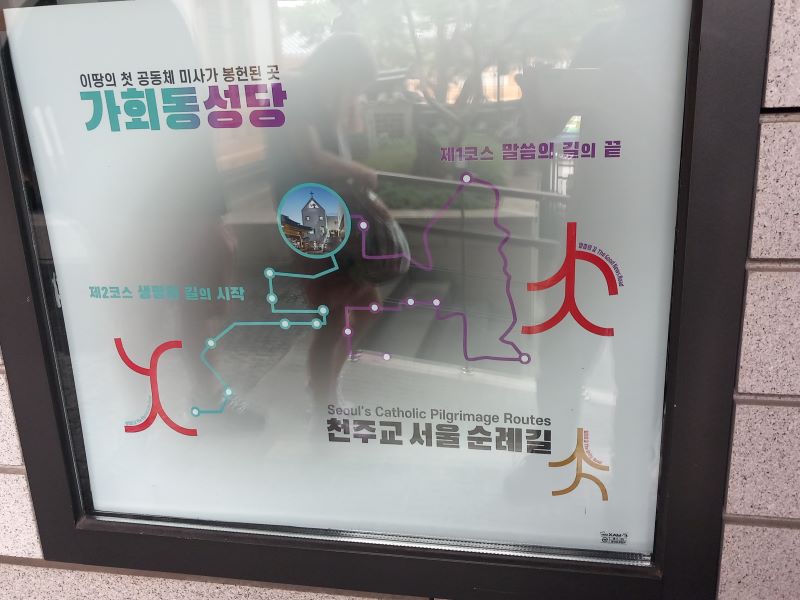
I assume they have other activities for Catholics during certain times. This pilgrimage map at the Gahoedong Catholic church near Bukchon Hanok village gives insight into their spiritual journeys in the area.
Korean Christian Museum at Soongsil University
From the Foreign Missionary Cemetery, I recommend the metro or a taxi to Soongsil University. The Museum is open Monday through Friday from 10:30 to 4:30 p.m. I recommend this as the next stop since this museum closes earlier. Unfortunately, the week I was in Seoul, the museum closed for renovation, but they gave me a few booklets on the place. The museum was started by Rev. Kim Yang-sun, who attended Soongsil schools and then the College. He began his collection of historic items near the 1930s, eventually making its home at the University in 1967.
The museum reflects the years of faithfulness of those who labored to educate Koreans, along with the areas of influence of Christianity. The many manuscripts and booklets give evidence of past generations’ faithfulness to sharing the gospel. Missionaries started this university in Korea and translated key academic books and subjects to encourage education.
Nestorians on the Korean Peninsula

The Nestorian stone, which was found in Gyeongju Bulguksa, on the eastern coast of Korea, is of prime interest in this museum. Most likely, the gospel came by Christian traders who entered the region from the sea. When you hear Nestorians, think of the Church of the East. The School of the Persians in Nisibis[2]now near the Turkiye and Syrian border spread the gospel along the Silk Road.
The Church of the East was very evangelical in spreading its faith, and it loved the cross. The stone gives the impression that the gospel influenced some on the Korean peninsula during the 8th and 9th centuries.[3]https://museum.ssu.ac.kr/en/exhibition/permanent-exhibition/history-hall-for-christianity-in-korea/ This is quite possible since the discovery of the Church of the East’s influence even on the island of Japan.[4]https://www.buddhismtoday.com/english/world/facts/108-japan.htm. In China, historians found a few Nestorian markers on the southwest side of Beijing. The Fangshan District, the Cross Temple site, displays the influence of the gospel in China.[5]https://antiokhos.home.blog/2019/04/28/nestorians-in-beijing/ – this site gives some good pictures of the monuments. The influence of the Church of the East has a long history and seems so long ago. Yet, the lack of scripture and a community of believers eventually only led to a few steles or crosses to testify of their gospel intent.[6]https://australian.museum/learn/cultures/international-collection/chinese/nestorian-stele-inscription-b11298/
Yonsei University
Our next stop is Yonsei University, and I recommend going to Sinchon Station (Seoul Subway Line #2) and taking exit #3 toward the university. The upper grounds of this university are quite beautiful, so I recommend an early evening stroll. The buildings and the markers outside give you a glimpse of the Christian history of this university.
In observing this location, I kept saying, “When they built a Christian university, they really built a university. The material gives evidence of their investment and long-term view in seeing the buildings last for over a century.
The buildings, called “Halls,” depict structures built in the 1920s with the intent to last a long time. The granite masonry and ivy on the semi-Gothic buildings give a Northwestern American feel to garden squares in the middle, of which two areas exist (one in front of Underwood Hall and one behind it). The early academics dedicated the halls to Underwood, Appenzeller, and Stimson – all missionary teachers connected to founding the university. The incorporation of Korean cultural symbols speaks to how the missionaries in Korea were open to the culture. The beginning of this section centers on a statue memorial to H.G. Underwood.



First Church in Seoul – Saemoonan Church
The best way to visit the church is when one is exploring near Gyeongbokgung Palace. In the lobby is a small exhibition in display cases.
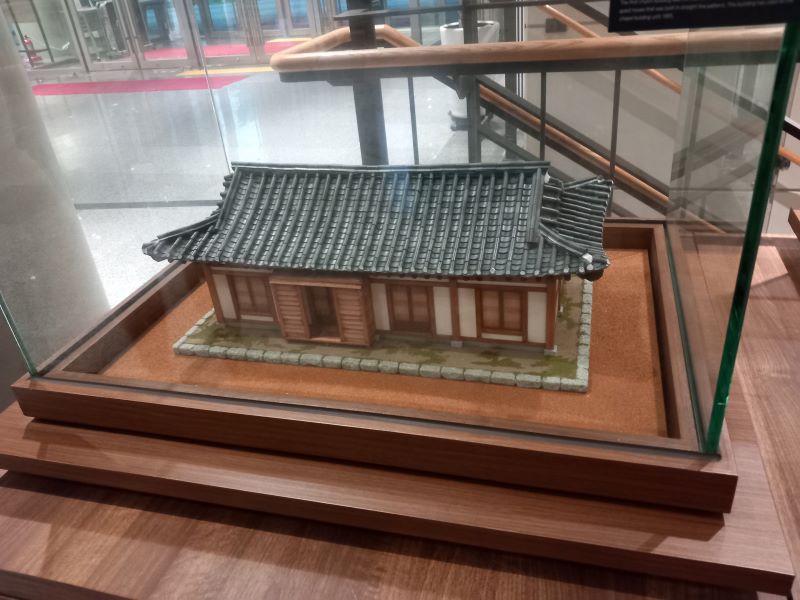
This replica demonstrates that the 1887 church was a small Korean-Oriental building. In the lobby, an open-to-the-public prayer chapel provides a peaceful respite from the outside city’s busyness. My wife and I prayed for Korea when we visited the chapel.
Four years before, the first Protestant church in Korea was founded in Songcheon at a church called “Sorea,” in which two Korean brothers started a group gathering each Sunday.
Other Christian-based locations
Ewha Woman’s University (located near to Yonsei University) was the first women’s university in Korea, started by missionaries. As one enters the campus, a museum on the left honors the many accomplishments of Korean women. Unfortunately, I did not get a chance to go to this museum since it closed a half hour before I arrived.
Severance Hospital was the first Western-style hospital in Korea. A historical write-up is found here. This hospital centers in the area between Yonsei and Ewha Woman’s University.
Another exciting write-up of revival in the early 1900s occurred with the people of Anju, located in North Korea.
The early Protestant missionaries in Korea stressed collaboration and excellence in some key social areas. One publication said, “Moreover, Protestant missionaries followed a policy of giving a significant amount of local authority to Koreans, who were then expected to support their own churches and conduct missionary work themselves, allowing them a significant amount of space to shape Christianity to their needs.”[7]https://www.asianstudies.org/publications/eaa/archives/christianity-in-korea/ In my brief day tour, I found this to be true. Those who came desired for God to work in the life of Koreans and empower them for ministry.
I have other walking tours that include Istanbul and Antalya, Turkiye. Please recommend this tour on your social media. Thanks!
References
| ↑1 | https://www.sciencedirect.com/science/article/pii/S122954501400028X |
|---|---|
| ↑2 | now near the Turkiye and Syrian border |
| ↑3 | https://museum.ssu.ac.kr/en/exhibition/permanent-exhibition/history-hall-for-christianity-in-korea/ |
| ↑4 | https://www.buddhismtoday.com/english/world/facts/108-japan.htm |
| ↑5 | https://antiokhos.home.blog/2019/04/28/nestorians-in-beijing/ – this site gives some good pictures of the monuments. |
| ↑6 | https://australian.museum/learn/cultures/international-collection/chinese/nestorian-stele-inscription-b11298/ |
| ↑7 | https://www.asianstudies.org/publications/eaa/archives/christianity-in-korea/ |
Leave a Reply